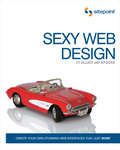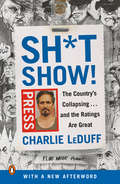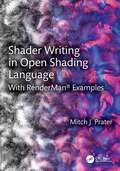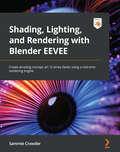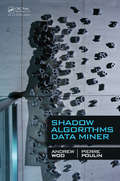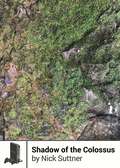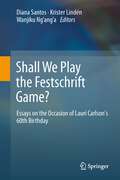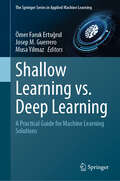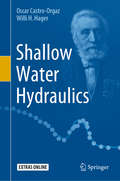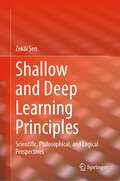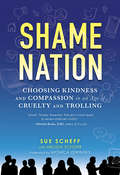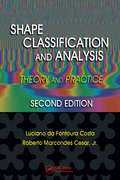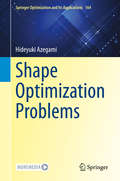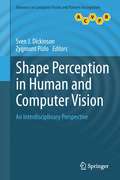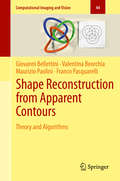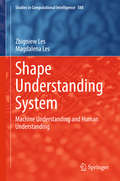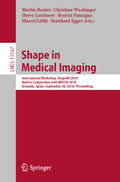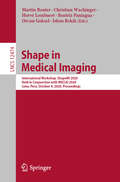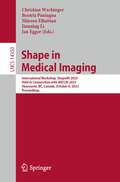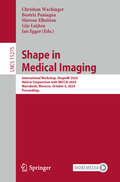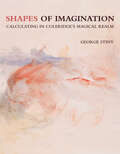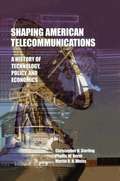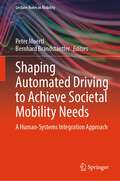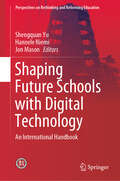- Table View
- List View
Sexy Web Design: Creating Interfaces that Work
by Elliot Jay StocksSexy Web Design is an easy-to-follow guide that reveals the secrets of how to build your own breathtaking web interfaces from scratch. You'll be guided through the entire process of creating a gorgeous, usable web site by applying the timeless principles of user-centered design. Even if you're short on design skills, with this book you'll be creating your own stunning web sites in no time at all. Throughout, the focus is on simple and practical techniques that anyone can use - you don't need to have gone to art school or have artistic flair to create stunning designs using the methods outlined in this book. The book's full-color layout and large format (8" x 10") make Sexy Web Design a pleasure to read. Master key web interface design principles Design amazing web interfaces from scratchCreate beautiful, yet functional, web sitesUnleash your artistic talentsAnd much more Who should read this book? Whether you're completely new to web design, a seasoned pro looking for inspiration, or a developer wanting to improve your sites' aesthetics, there's something for everyone here. How? Because instead of trying to cover every possible area of creating a web site, we've focused purely on the design stage; that is, everything that happens before a single line of code is written. However, great design is more than just aesthetics. Long before we open our graphics program of choice, we'll be conducting research, dealing with clients, responding to briefs, sketching out sitemaps, planning information architecture, moving from doodles to diagrams, exploring different ways of interactivity, and building upon design traditions. But ultimately, you'll be finding out how to create web sites that look drop-dead gorgeous.
Sh**ged. Married. Annoyed.: The Sunday Times No. 1 Bestseller
by Chris Ramsey Rosie RamseyWhether you've barely recovered from spending lockdown with your other half or desperately heading back to the clubs to meet 'the one', SH**GED. MARRIED. ANNOYED. is here to see you through . . .THE SUNDAY TIMES BESTSELLER FROM THE STARS OF THE CHART-TOPPING PODCASTNOW FEATURING A BONUS CHAPTER'An absolute triumph' Daisy May Cooper'These two are bloody hilarious' Zoe Sugg'A hilarious look at the highs and lows of relationships' Sun__________SH**GED.Hitting the bars, necking drinks and necking strangers, stumbling home, one-night-stands, nightmare dates, thinking this one's alright, ghosting, tears, more drinking, living off late-night chips.MARRIED.Meeting 'the one', weekends away, moving in, declaring life-long love, stags and hens, the perfect wedding, the honeymoon period, getting through the hard bits together, starting a family.ANNOYED.Can you close the bathroom door if you're doing that? Sleepless nights, arguing about whose turn it is to change the baby's nappy, toys everywhere, only having two drinks, still being hungover, wondering when it all stopped being easy.Whether you're sh**ged, married, annoyed, or all of the above, Chris and Rosie Ramsey write hilariously and with honesty about the ups and downs of dating, relationships, arguing, parenting and everything in between.
Sh*tshow!: The Country's Collapsing . . . and the Ratings Are Great
by Charlie LeDuffA daring, firsthand, and utterly-unscripted account of crisis in America, from Ferguson to Flint to Cliven Bundy's ranch to Donald Trump's unstoppable campaign for President--at every turn, Pulitzer-prize winner and bestselling author of Detroit: An American Autopsy, Charlie LeDuff was thereIn the Fall of 2013, long before any sane person had seriously considered the possibility of a Trump presidency, Charlie LeDuff sat in the office of then-Fox News CEO Roger Ailes, and made a simple but prophetic claim: The whole country is bankrupt and on high boil. It’s a shitshow out there. No one in the bubbles of Washington, DC., New York, or Los Angles was talking about it--least of all the media. LeDuff wanted to go to the heart of the country to report what was really going on. Ailes baulked. Could the hard-living and straight-shooting LeDuff be controlled? But, then, perhaps on a whim, he agreed. And so LeDuff set out to record a TV series called, "The Americans," and, along the way, ended up bearing witness to the ever-quickening unraveling of The American Dream.For three years, LeDuff travelled the width and breadth of the country with his team of production irregulars, ending up on the Mexican border crossing the Rio Grande on a yellow rubber kayak alongside undocumented immigrants; in the middle of Ferguson as the city burned; and watching the children of Flint get sick from undrinkable water. Racial, political, social, and economic tensions were escalating by the day. The inexorable effects of technological change and globalization were being felt more and more acutely, at the same time as wages stagnated and the price of housing, education, and healthcare went through the roof. The American people felt defeated and abandoned by their politicians, and those politicians seemed incapable of rising to the occasion. The old way of life was slipping away, replaced only by social media, part-time work, and opioid addiction.Sh*tshow! is that true, tragic, and distinctively American story, told from the parts of the country hurting the most. A soul-baring, irreverent, and iconoclastic writer, LeDuff speaks the language of everyday Americans, and is unafraid of getting his hands dirty. He scrambles the tired-old political, social, and racial categories, taking no sides--or prisoners. Old-school, gonzo-style reporting, this is both a necessary confrontation with the darkest parts of the American psyche and a desperately-needed reminder of the country's best instincts.
Shader Writing in Open Shading Language: With RenderMan® Examples
by Mitch J. PraterIncorporating both historical techniques and the most recent developments in computer graphics, Shader Writing in Open Shading Language is a treatise on OSL shader writing and shader development that intends to remedy the current lack of material on this important area of technical and artistic expertise. It is for artists who wish to know more about shaders and shader writing, for programmers who want the ultimate in creative control, or for anyone in‑between.It begins by covering the entire range of independent variables upon which all shaded pattern generation is based. From that foundation, every fundamental procedural, textural, conversion, and pattern modification shader category is described with clear and practical examples.Each topic is presented in a progression of chapters that begin with the fundamentals and expand to more complex shaders illustrating more advanced techniques that build on the previously covered material.In addition, these important topics are also covered: Shader user interface design and parameter widgets Color, color models, color spaces, and color transformations 2d and 3d spaces and their transformations Texture patterns and projections Ray tracing for pattern generation Displacement and bumped shading normal generation Shader organization, building, and deployment Shader execution and debugging
Shading, Lighting, and Rendering with Blender EEVEE: Create amazing concept art 12 times faster using a real-time rendering engine
by Sammie CrowderGet to grips with new real-time animation techniques and tricks to improve your artistic and technical skills in shading, 3D rendering, and scene creation using Blender 3.0Key FeaturesLearn real-time rendering engine concepts by creating three projectsUnderstand how to update workflows to Blender 3.0Explore intermediate to advanced-level tutorials on creating art inside BlenderBook DescriptionBlender is the most important up-and-coming 3D software package in the world. EEVEE, a state-of-the-art real-time rendering engine is a fairly new addition to Blender and provides the capacity to create artwork at blazing speed, almost 12 times faster than Cycles.Lighting, Shading, and Rendering with Blender's EEVEE provides a high-level overview of what EEVEE is capable of, then teaches users about Geometry Nodes, Rendering Techniques, using shortcuts like Kitbashing and Alphas to speed up scene creation, volumetrics, reflections, adding lights, cameras and even special effects like fire and smoke, all in EEVEE. All of this is in the context of creating actual scenes that readers will work through from start to finish. By the time a Blender Artist completes the book, they will have created three separate works that have challenged them to iterate and design with the full power of Blender's EEVEE.What you will learnExplore EEVEE Render Properties for optimal outcomesFocus on shading processes, including those that are both traditional and more cutting-edgeUnderstand composition and create effective concept art inside BlenderDiscover procedural workflows to shorten the artistic process instead of getting mired in detailsUnderstand intermediate Blender workflows for working in a professional environmentDevelop art in different styles and learn why each style has different workflows and conventionsCreate interactive, rapid changes in Blender's EEVEE engineWho this book is forThis book is for 3D animators, sculptors, modelers, and concept artists who want to use EEVEE to speed up their work in movies, TV, and game design. Readers are expected to have a basic to intermediate-level understanding of 3D programs and ray-tracing engines.
Shadow Algorithms Data Miner
by Andrew Woo Pierre PoulinShadow Algorithms Data Miner provides a high-level understanding of the complete set of shadow concepts and algorithms, addressing their usefulness from a larger graphics system perspective. It discusses the applicability and limitations of all the direct illumination approaches for shadow generation.With an emphasis on shadow fundamentals, the boo
Shadow of the Colossus (Boss Fight Books)
by Nick SuttnerA massive, open world, brimming with mystery. A gauntlet of giants to overcome, living levels that must be destroyed... but to what end? Since its 2005 release, Fumito Ueda's minimal-yet-epic masterpiece, Shadow of the Colossus, has often been hailed as one of the greatest video games of all time. But why is Shadow still utterly unique over a decade later? Nick Suttner examines this question and others while journeying across Shadow&’s expanses—stopping along the way to speak to developers about the game&’s influence, examine the culture around its unfinished mysteries, and investigate the game's colossal impact on his own beliefs about games, art, and life.
Shall We Play the Festschrift Game?
by Krister Lindén Diana Santos Wanjiku Ng’ang’aThere are not many people who can be said to have influenced and impressed researchers in so many disparate areas and language-geographic fields as Lauri Carlson, as is evidenced in the present Festschrift. His insight and acute linguistic sensitivity and linguistic rationality have spawned findings and research work in many areas, from non-standard etymology to hardcore formal linguistics, not forgetting computational areas such as parsing, terminological databases, and, last but not least, machine translation. In addition to his renowned and widely acknowledged insights in tense and aspect and its relationship with nominal quantification, and his ground-breaking work in dialog using game-theoretic machinery, Lauri has in the last fifteen years as Professor of Language Theory and Translation Technology contributed immensely to areas such as translation, terminology and general applications of computational linguistics. The three editors of the present volume have successfully performed doctoral studies under Lauri's supervision, and wish with this volume to pay tribute to his supervision and to his influence in matters associated with research and scientific, linguistic and philosophical inquiry, as well as to his humanity and friendship.
Shallow Learning vs. Deep Learning: A Practical Guide for Machine Learning Solutions (The Springer Series in Applied Machine Learning)
by Josep M. Guerrero Ömer Faruk Ertuğrul Musa YilmazThis book explores the ongoing debate between shallow and deep learning in the field of machine learning. It provides a comprehensive survey of machine learning methods, from shallow learning to deep learning, and examines their applications across various domains. Shallow Learning vs Deep Learning: A Practical Guide for Machine Learning Solutions emphasizes that the choice of a machine learning approach should be informed by the specific characteristics of the dataset, the operational environment, and the unique requirements of each application, rather than being influenced by prevailing trends. In each chapter, the book delves into different application areas, such as engineering, real-world scenarios, social applications, image processing, biomedical applications, anomaly detection, natural language processing, speech recognition, recommendation systems, autonomous systems, and smart grid applications. By comparing and contrasting the effectiveness of shallow and deep learning in these areas, the book provides a framework for thoughtful selection and application of machine learning strategies. This guide is designed for researchers, practitioners, and students who seek to deepen their understanding of when and how to apply different machine learning techniques effectively. Through comparative studies and detailed analyses, readers will gain valuable insights to make informed decisions in their respective fields.
Shallow Water Hydraulics
by Willi H. Hager Oscar Castro-OrgazThis book presents the theory and computation of open channel flows, using detailed analytical, numerical and experimental results. The fundamental equations of open channel flows are derived by means of a rigorous vertical integration of the RANS equations for turbulent flow. In turn, the hydrostatic pressure hypothesis, which forms the core of many shallow water hydraulic models, is scrutinized by analyzing its underlying assumptions. The book’s main focus is on one-dimensional models, including detailed treatments of unsteady and steady flows. The use of modern shock capturing finite difference and finite volume methods is described in detail, and the quality of solutions is carefully assessed on the basis of analytical and experimental results.The book’s unique features include:• Rigorous derivation of the hydrostatic-based shallow water hydraulic models• Detailed treatment of steady open channel flows, including the computation of transcritical flow profiles• General analysis of gate maneuvers as the solution of a Riemann problem• Presents modern shock capturing finite volume methods for the computation of unsteady free surface flows• Introduces readers to movable bed and sediment transport in shallow water models• Includes numerical solutions of shallow water hydraulic models for non-hydrostatic steady and unsteady free surface flowsThis book is suitable for both undergraduate and graduate level students, given that the theory and numerical methods are progressively introduced starting with the basics. As supporting material, a collection of source codes written in Visual Basic and inserted as macros in Microsoft Excel® is available. The theory is implemented step-by-step in the codes, and the resulting programs are used throughout the book to produce the respective solutions.
Shallow and Deep Learning Principles: Scientific, Philosophical, and Logical Perspectives
by Zekâi ŞenThis book discusses Artificial Neural Networks (ANN) and their ability to predict outcomes using deep and shallow learning principles. The author first describes ANN implementation, consisting of at least three layers that must be established together with cells, one of which is input, the other is output, and the third is a hidden (intermediate) layer. For this, the author states, it is necessary to develop an architecture that will not model mathematical rules but only the action and response variables that control the event and the reactions that may occur within it. The book explains the reasons and necessity of each ANN model, considering the similarity to the previous methods and the philosophical - logical rules.
Shame Nation: The Global Epidemic Of Online Hate
by Melissa Schorr Sue Scheff Monica Lewinksy"Engaging, sharp, and important — Shame Nation will inspire you to open your eyes and be better." — Theresa Payton, CEO of Fortalice Solutions and Deputy Director of Intelligence on CBS' HuntedIn today's digitally driven world, disaster is only a click away. A rogue tweet could bring down a business; an army of trolls can run a celebrity off-line; and virtual harassment might cause real psychological damage. Shame Nation is the first book to both study the fascinating phenomenon of online shaming, and offer practical guidance and inspiring advice on how to prevent and protect against cyber blunders and faceless bullies. Author and acclaimed Internet safety expert Sue Scheff unveils all sides of an issue that it only becoming more relevant day by day while drawing from the expertise of other top professionals spanning fields including law, psychology, and reputation management.From damning screenshots to revenge porn, Shame Nation shines a light on the rising trend of an online shame culture and empowers readers to take charge of their digital lives.
Shape Classification and Analysis: Theory and Practice, Second Edition (Image Processing Series)
by Luciano da Costa Roberto Marcond Cesar, Jr.Because the properties of objects are largely determined by their geometric features, shape analysis and classification are essential to almost every applied scientific and technological area. A detailed understanding of the geometrical features of real-world entities (e.g., molecules, organs, materials and components) can provide important clues about their origin and function. When properly and carefully applied, shape analysis offers an exceedingly rich potential to yield useful applications in diverse areas ranging from material sciences to biology and neuroscience.Get Access to the Authors’ Own Cutting-Edge Open-Source Software Projects—and Then Actually Contribute to Them Yourself! The authors of Shape Analysis and Classification: Theory and Practice, Second Edition have improved the bestselling first edition by updating the tremendous progress in the field. This exceptionally accessible book presents the most advanced imaging techniques used for analyzing general biological shapes, such as those of cells, tissues, organs, and organisms. It implements numerous corrections and improvements—many of which were suggested by readers of the first edition—to optimize understanding and create what can truly be called an interactive learning experience. New Material in This Second Edition Addresses Graph and complex networks Dimensionality reduction Structural pattern recognition Shape representation using graphs Graphically reformulated, this edition updates equations, figures, and references, as well as slides that will be useful in related courses and general discussion. Like the popular first edition, this text is applicable to many fields and certain to become a favored addition to any library. Visit http://www.vision.ime.usp.br/~cesar/shape/ for Useful Software, Databases, and Videos
Shape Optimization Problems (Springer Optimization and Its Applications #164)
by Hideyuki AzegamiThis book provides theories on non-parametric shape optimization problems, systematically keeping in mind readers with an engineering background. Non-parametric shape optimization problems are defined as problems of finding the shapes of domains in which boundary value problems of partial differential equations are defined. In these problems, optimum shapes are obtained from an arbitrary form without any geometrical parameters previously assigned. In particular, problems in which the optimum shape is sought by making a hole in domain are called topology optimization problems. Moreover, a problem in which the optimum shape is obtained based on domain variation is referred to as a shape optimization problem of domain variation type, or a shape optimization problem in a limited sense. Software has been developed to solve these problems, and it is being used to seek practical optimum shapes. However, there are no books explaining such theories beginning with their foundations.The structure of the book is shown in the Preface. The theorems are built up using mathematical results. Therefore, a mathematical style is introduced, consisting of definitions and theorems to summarize the key points. This method of expression is advanced as provable facts are clearly shown. If something to be investigated is contained in the framework of mathematics, setting up a theory using theorems prepared by great mathematicians is thought to be an extremely effective approach. However, mathematics attempts to heighten the level of abstraction in order to understand many things in a unified fashion. This characteristic may baffle readers with an engineering background. Hence in this book, an attempt has been made to provide explanations in engineering terms, with examples from mechanics, after accurately denoting the provable facts using definitions and theorems.
Shape Perception in Human and Computer Vision: An Interdisciplinary Perspective
by Sven J. Dickinson Zygmunt PizloThis comprehensive and authoritative text/reference presents a unique, multidisciplinary perspective on Shape Perception in Human and Computer Vision. Rather than focusing purely on the state of the art, the book provides viewpoints from world-class researchers reflecting broadly on the issues that have shaped the field. Drawing upon many years of experience, each contributor discusses the trends followed and the progress made, in addition to identifying the major challenges that still lie ahead. Topics and features: examines each topic from a range of viewpoints, rather than promoting a specific paradigm; discusses topics on contours, shape hierarchies, shape grammars, shape priors, and 3D shape inference; reviews issues relating to surfaces, invariants, parts, multiple views, learning, simplicity, shape constancy and shape illusions; addresses concepts from the historically separate disciplines of computer vision and human vision using the same "language" and methods.
Shape Reconstruction from Apparent Contours
by Giovanni Bellettini Valentina Beorchia Maurizio Paolini Franco PasquarelliMotivated by a variational model concerning the depth of the objects in a picture and the problem of hidden and illusory contours, this book investigates one of the central problems of computer vision: the topological and algorithmic reconstruction of a smooth three dimensional scene starting from the visible part of an apparent contour. The authors focus their attention on the manipulation of apparent contours using a finite set of elementary moves, which correspond to diffeomorphic deformations of three dimensional scenes. A large part of the book is devoted to the algorithmic part, with implementations, experiments, and computed examples. The book is intended also as a user's guide to the software code appcontour, written for the manipulation of apparent contours and their invariants. This book is addressed to theoretical and applied scientists working in the field of mathematical models of image segmentation.
Shape Understanding System
by Zbigniew Les Magdalena LesThis is the third book presenting selected results of research on the further development of the shape understanding system (SUS) carried out by authors in the newly founded Queen Jadwiga Research Institute of Understanding. In this book the new term Machine Understanding is introduced referring to a new area of research aiming to investigate the possibility of building machines with the ability to understand. It is presented that SUS needs to some extent mimic human understanding and for this reason machines are evaluated according to the rules applied for the evaluation of human understanding. The book shows how to formulate problems and how it can be tested if the machine is able to solve these problems.
Shape in Medical Imaging: International Workshop, ShapeMI 2018, Held in Conjunction with MICCAI 2018, Granada, Spain, September 20, 2018, Proceedings (Lecture Notes in Computer Science #11167)
by Martin Reuter Christian Wachinger Hervé Lombaert Beatriz Paniagua Marcel Lüthi Bernhard EggerThis book constitutes the proceedings of the Workshop on Shape in Medical Imaging, ShapeMI 2018, held in conjunction with the 21st International Conference on Medical Image Computing, MICCAI 2018, in Granada, Spain, in September 2018. The 26 full papers and 2 short papers presented were carefully reviewed and selected for inclusion in this volume. The papers discuss novel approaches and applications in shape and geometry processing and their use in research and clinical studies and explore novel, cutting-edge theoretical methods and their usefulness for medical applications, e.g., from the fields of geometric learning or spectral shape analysis.
Shape in Medical Imaging: International Workshop, ShapeMI 2020, Held in Conjunction with MICCAI 2020, Lima, Peru, October 4, 2020, Proceedings (Lecture Notes in Computer Science #12474)
by Martin Reuter Christian Wachinger Hervé Lombaert Orcun Goksel Islem Rekik Beatriz PaniaguaThis book constitutes the proceedings of the International Workshop on Shape in Medical Imaging, ShapeMI 2020, which was held in conjunction with the 23rd International Conference on Medical Image Computing and Computer Assistend Intervention, MICCAI 2020, in October 2020. The conference was planned to take place in Lima, Peru, but changed to a virtual format due to the COVID-19 pandemic. The 12 full papers included in this volume were carefully reviewed and selected from 18 submissions. They were organized in topical sections named: methods; learning; and applications.
Shape in Medical Imaging: International Workshop, ShapeMI 2023, Held in Conjunction with MICCAI 2023, Vancouver, BC, Canada, October 8, 2023, Proceedings (Lecture Notes in Computer Science #14350)
by Christian Wachinger Beatriz Paniagua Jan Egger Jianning Li Shireen ElhabianThis volume comprises the proceedings of the International Workshop, ShapeMI 2023, which took place alongside MICCAI 2023 on October 8, 2023, in Vancouver, British Columbia, Canada.The 23 selected full papers deal with all aspects of leading methods and applications for advanced shape analysis and geometric learning in medical imaging.
Shape in Medical Imaging: International Workshop, ShapeMI 2024, Held in Conjunction with MICCAI 2024, Marrakesh, Morocco, October 6, 2024, Proceedings (Lecture Notes in Computer Science #15275)
by Christian Wachinger Beatriz Paniagua Jan Egger Shireen Elhabian Gijs LuijtenThis book constitutes the proceedings of the International Workshop on Shape in Medical Imaging, ShapeMI 2024, which took place in Marrakesh, Morocco, on October 6, 2024, held in conjunction with MICCAI 2024. The 16 full papers included in this book were carefully reviewed and selected from 24 submissions. They focus on shape and spectral analysis, geometric learning and modeling algorithms, and application-driven research.
Shapes of Imagination: Calculating in Coleridge's Magical Realm
by George StinyVisual calculating in shape grammars aligns with art and design, bridging the gap between seeing (Coleridge's &“imagination&”) and combinatoric play (Coleridge's &“fancy&”).In Shapes of Imagination, George Stiny runs visual calculating in shape grammars through art and design—incorporating Samuel Taylor Coleridge's poetic imagination and Oscar Wilde's corollary to see things as they aren't. Many assume that calculating limits art and design to suit computers, but shape grammars rely on seeing to prove otherwise. Rules that change what they see extend calculating to overtake what computers can do, in logic and with data and learning. Shape grammars bridge the divide between seeing (Coleridge's &“imagination, or esemplastic power&”) and combinatoric play (Coleridge's &“fancy&”).Stiny shows that calculating without seeing excludes art and design. Seeing is key for calculating to augment creative activity with aesthetic insight and value. Shape grammars go by appearances, in a full-fledged aesthetic enterprise for the inconstant eye; they answer the question of what calculating would be like if Turing and von Neumann were artists instead of logicians. Art and design are calculating in all their splendid detail.
Shaping American Telecommunications: A History of Technology, Policy, and Economics (LEA Telecommunications Series)
by Christopher H. Sterling Phyllis W. Bernt Martin B.H. WeissShaping American Telecommunications examines the technical, regulatory, and economic forces that have shaped the development of American telecommunications services. This volume is both an introduction to the basic technical, economic, and regulatory principles underlying telecommunications, and a detailed account of major events that have marked development of the sector in the United States. Beginning with the introduction of the telegraph and continuing through to current developments in wireless and online services, authors Christopher H. Sterling, Phyllis W. Bernt, and Martin B.H. Weiss explain each stage of telecommunications development, examining the interplay among technical innovation, policy decisions, and regulatory developments.Offering an integrated treatment of the interplay among technology, policy, and economics as key factors defining the development of the telecommunications sector in the United States, this volume also provides:*background material to facilitate understanding of each sector;*contexts for many so-called "new" issues, problems, and trends, demonstrating origins from years or decades in the past; and*careful annotation, documentation, and reference tables to enable further research on the topics discussed.This unique multidisciplinary approach provides a balanced view of U.S. telecommunications history, in context with relevant economic, legal, social, and technical analyses. As such, it is essential reading for advanced students in telecommunications needing to understand how the telecommunications industry and service developed to its current form. The volume will also serve as a supplemental text in courses on telecommunications regulation, and it will be of value to professionals in the field seeking context and background for their daily work.
Shaping Automated Driving to Achieve Societal Mobility Needs: A Human-Systems Integration Approach (Lecture Notes in Mobility)
by Peter Moertl Bernhard BrandstaetterThis edited book describes novel human-systems integration approaches to improve acceptance, safety, and comfort of automated vehicles. Each chapter analyses different aspects in the development of automated driving systems such as: assessing needs and opportunities of specific user populations i.e. elderly drivers and truck drivers; creating fluid human-systems interactions in the vehicle to answer specific driver needs; developing an automated driving tutoring application; and identifying benefits of including road infrastructure sensors to support automated driving predictability. A detailed description of the assessment of the above-described solutions in real-world situations is also included. Written by both researchers and professionals, this book offers timely and practice-oriented information concerning the development of automated driving systems that better adapt to the users’ needs.
Shaping Future Schools with Digital Technology: An International Handbook (Perspectives on Rethinking and Reforming Education)
by Shengquan Yu Hannele Niemi Jon MasonThis book presents an overview of education technology and its use in schools, with a primary emphasis on best practices of technology enhanced learning; how new technologies such as mobile, augmented and wearable technologies affect instructional design strategies; and the content curriculum development process. Providing insights into the future of education and the upcoming pedagogies that will be applied in schools, it helps educators and other stakeholders make innovations for the new generations of learners in the 21st century.The use of emerging technologies such as mobile and ubiquitous technologies, context-aware technology, augment-reality, and virtual reality is contributing to making education adaptive and smarter. With the ever-changing technologies, how to equip teachers with these digital skills and transform their teaching style is also important to ensure that school education is more individualised and customised for students.Offering a global perspective with integrated practical cases, this timely book is of interest to educators, teachers, and education policymakers. And although most of the authors are from the academia, it provides non-experts with a novel view of what future schools will be like with the help of technology.
